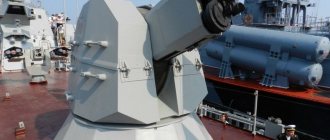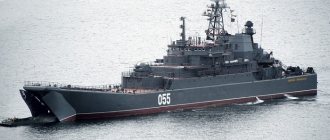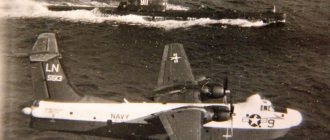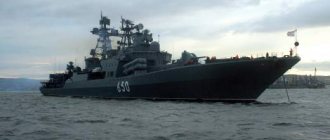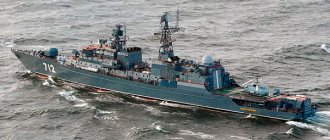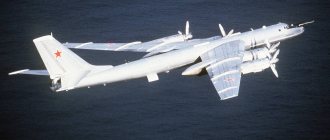The large landing ship "Ivan Gren" during the passage from Kaliningrad to Severomorsk A special part of the navy's tasks is the landing of troops on the coast. Such operations require the use of special equipment, primarily large landing ships (LDC). The United States of America was the most successful in their development and construction, but the USSR also had some success in this area. For a long time, the Russian fleet had to use the Soviet legacy, and only in 2020 the new large landing ship Ivan Gren was introduced into the navy. It took 14 long years to build it.
History of creation
In the first years of the twenty-first century, the Russian Navy had at its disposal about two dozen large landing ships built according to projects 775 and 1171. All of them came off the stocks before the collapse of the Soviet Union and were gradually aging. In general, the Navy command foresaw this situation - back in 1998, the terms of reference for the development of a new large landing craft were approved, which then went to the Nevsky Design Bureau, which had extensive experience in creating surface ships.
However, one should not exaggerate the foresight of naval commanders. Their original plan involved the creation of small landing craft with a shallow draft that could be transferred along rivers from one sea to another. This feature looked quite tempting, but ships manufactured according to the appropriate requirements could not be large in size - and the Navy command did not like this.
BDK "Saratov" (formerly "Voronezh Komsomolets"), built according to project 1171 "Tapir"
As a result, even at the preliminary design stage, the technical specifications were significantly revised. Now we are talking about creating a large landing ship with a displacement of four to six thousand tons. This “sharp turn” was not the last: in just over five years, from 1998 to 2003, the terms of reference were revised three times.
Ultimately, the shipbuilders decided not to take risks by creating something fundamentally new, but to rely on the already existing and proven design of large landing ships of Project 1171 “Tapir”. The fleet had quite significant and generally positive experience in their operation. In addition, at the end of the 80s, the Nevsky Design Bureau was already designing an improved version of the Tapir; these developments were preserved and could be used.
It must be said that much larger landing ships were also built in the USSR, the displacement of which reached 13 thousand tons. These were ships of Project 1174. They were not used as a base model, since the technical specifications stated that the new BDKs were intended for operations only in two places - in the Baltic and in the Black Sea. Both of these water areas are relatively small, so for landing it makes more sense to build medium-sized ships with a shallow draft.
The new project was designated 11711, and they decided to name the lead landing craft in honor of Ivan Gren, the vice admiral who headed the naval artillery that defended Leningrad during the Great Patriotic War. The new ship was laid down at the very end of 2004, after the preliminary design stage was finally completed.
Awareness of the problem
The consequences of the collapse of the USSR by the beginning of the 21st century backfired with an almost landslide reduction in the ship strength of the Russian Navy. Large landing ships were also among the casualties. Of the three largest large landing ships of Project 1174 (total displacement 14,060 tons), all three left the “game.” Of the 14 old BDKs of Project 1171 (total displacement 4360 tons), 4 remained. Of the 27 BDKs Project 775 (total displacement 4400 tons), 15 survived in service.
At the same time, it was the BDK that turned out to be perhaps the most popular warships of the Navy. True, this was explained not by the fact that our Fleet had to continuously land amphibious assault forces, but by the fact that this very Fleet did not have troop transports. The surviving large landing craft had to be used as such. At the same time, of course, they were wasting their precious resource and certainly weren’t getting any younger...
shipyard-yantar.ru /
The need to build new large landing ships to replace Soviet-era ships was fully realized by the command of the Russian Navy back at the end of the “wild nineties.” But what kind of landing ships does the Navy need? Answering this question was not as simple as it might seem.
For example, in the United States, the idea of landing people and equipment on an unequipped coast directly from large landing ships was already considered an anachronism by this time. A large ship is a large target. To drive a large landing ship directly towards the enemy shore was to deliberately expose it to attack. Therefore, the US Navy was actively developing the doctrine of “over-the-horizon landing” and “vertical coverage.”
According to it, the landing ship remained out of sight from the enemy shore, and the landing of people and equipment was carried out by high-speed craft and helicopters based on the “landing ship”. Especially for this doctrine, the United States built universal landing ships with a total displacement of over 40,000 tons, capable of carrying not only several dozen helicopters and vertical take-off and landing aircraft, but also 12 landing boats with the possibility of replacing a dozen landing boats with three air-cushioned landing craft.
The USSR Navy, at the peak of its development, also began to “approach” something similar. For this reason, the Project 1174 landing craft with four Ka-29 helicopters each were laid down. In addition to helicopters, these large landing craft could also receive a variety of landing craft into the docking chamber. But the use of gas turbine units and the shortcomings of the general layout predetermined the short life of the Project 1174 BDK in the Russian Navy. Due to objective reasons, these ships quickly became unusable...
wikipedia.org/
Stages and progress of construction of a new generation of landing ships
The initial stage of construction of the BDK "Ivan Gren"
The construction of the BDK "Ivan Gren" was carried out in Kaliningrad, at the shipbuilding plant. The manufacturing process turned out to be long and difficult. The main cause of the problems was the extremely changeable and unpredictable behavior of the customer. Funding was often interrupted, which led to a halt in all work.
I myself was in an extremely difficult situation. The complete absence of large orders throughout the 90s threatened the very existence of this enterprise. Already during the construction of Ivan Gren, a bankruptcy procedure was begun for the plant, which was supposed to pass from the hands of the state to private ownership, which would inevitably end with the sale of surviving assets and final liquidation. Only the personal intervention of Vladimir Putin prevented such a development of events.
Years passed, the Navy command periodically put forward new demands, but the ship remained unfinished. Its design gradually became better, but this process was extremely slow. New troubles began in 2008. They were associated primarily with the global financial crisis, due to which the entire Russian economy was seriously damaged. Almost simultaneously, the country’s military leadership came up with the idea of purchasing the French Mistral universal landing helicopter carriers, which had the most negative impact on the future fate of the Project 11711 BDK.
"Ivan Gren" shortly before launching in 2012. The ship took so long to build that some of its structural elements had time to rust.
It is incorrect to compare the Ivan Gren directly with the Mistrals - the Russian BDK is four times smaller than the French ship, which also uses a much more advanced type of landing with an “over-the-horizon” landing. Therefore, of course, there was no direct competition here. Nevertheless, interest in “Ivan Gren” from the Navy command disappeared again, and money flows flowed in the other direction. As a result, already in 2010, the threat of bankruptcy of the shipbuilding company again arose.
At first, the trial was stopped, but a year later, VTB Bank for the third time demanded the official recognition of the insolvency of the Yantar plant and the sale of the company’s property. The Russian government was involved in the subsequent proceedings. It was reported, in particular, that the plant’s management was forced to spend the money allocated for the construction of the Ivan Gren on the production of the experimental vessel Seliger.
In May 2012, Ivan Gren, the first large landing ship, 70% completed by that time, was finally launched. In any case, this did not comply with the terms of the contract, since they stipulated that in 2012 the Ivan Gren would not only leave the stocks, but would already be handed over to the customer. A new agreement had to be concluded. Referring to chronic underfunding, representatives proposed to complete the ship as an ordinary transport vessel, refusing to place helicopters and weapons on it.
The assembly work on the Ivan Gren landing ship was frankly careless - the gap between the ceiling of the navigation bridge and the edging of the niche is clearly visible
The Navy command, however, was not ready for such a radical “change of course.” A counterproposal was put forward to complete the construction of the landing ship. The military department promised to repay all existing debt to finance the contract and went even further, declaring its desire to receive five more ships like the Ivan Gren. Soon, however, these promises were “cut down” - by the end of 2012, there was talk of only one more large landing ship of Project 11711.
After long and painful negotiations for both sides, the parties finally agreed that the Ivan Gren would be converted into a transport ship only partially - they would remove some of the weapons and adapt the ship to transport standard cargo containers on the upper deck.
As one might expect, the completion of the first large landing ship and its testing also took a long time. Problems arose one after another, and often they were associated not with any design errors, but with poor quality of work. In the meantime (more precisely, in June 2015), the laying ceremony of another ship of Project 11711 took place. It was named “Petr Morgunov”.
The turning point in this entire overly long story was the year 2020. At the end of May, the large landing craft "Peter Morgunov" was launched in a solemn ceremony. A month later, already in June, the Ivan Gren was introduced into the Russian Navy. In October, he arrived at his permanent place of service, the main base of the Northern Fleet. Perhaps it was these events that prompted the naval command to once again reconsider its plans and order two more ships of Project 11711.
Laying down ceremony for two new Project 11711 landing ships
Their laying took place on April 23, 2022. The new landing craft will be named Vasily Trushin and Vladimir Andreev. It is already known that both ships will be significantly different from their “predecessors”. In particular, the displacement will be increased, and the configuration of the flight deck for helicopters will also change.
Despite such a significant revision of the design, they decided to keep the design number, which is somewhat unusual. However, given the complex and tortuous biography of “Ivan Gren,” one can assume that everything will change more than once.
Composition of the series
The total number of planned ships in the series is six.
Military experts see the reason for the delay in the construction of the second ship as the fact that the fate of the entire project will only be clear after testing the lead ship. Before production starts, the complex will be rolled out so that it becomes clear what additions and changes the project needs. The duration of future tests is approximately one year.
- "Ivan Gren"; Serial number – 01301; Laid down - December 23, 2004; Launching - May 18, 2012; Commissioning – 2015 (plan)
- "Peter Morgunov"; Serial number – 01302; Launching - 2016 (plan); Commissioning – 2022 (plan).
Design Features
The main difference between the Project 11711 ships and the old Soviet BDKs is a fundamentally different landing scheme. "Tapirs" landed marines and military equipment using a ramp, approaching as close to the shore as possible under the terrain conditions. "Ivan Gren" during the landing can remain at a considerable distance from the water's edge. In this case, equipment is disembarked along a pontoon “crossing” connecting the landing craft with the shore.
This scheme makes it possible to guarantee the landing of tanks, which was previously possible only under favorable circumstances. Many foreign landing ships have mastered this method of landing quite a long time ago, but Russian large landing ships have not yet had such capabilities.
Housing layout
The main interior of Project 11711 ships is a through cargo hold running along the entire length of the hull. The front and rear ramps covering it allow disembarkation in any direction. Equipment for non-contact landing using engineering pontoons is located in the bow of the hull, which has a rather characteristic curved shape.
Front view of the large landing craft "Ivan Gren". The closed doors of the front ramp are clearly visible
There are two superstructures on the upper deck - a five-tier bow and a four-tier aft. Between them there are two cranes, which are used when unloading light armored vehicles and trucks onto the quay wall (they can be transported both in the landing hold and on the upper deck).
Inside the aft superstructure there is a helicopter hangar with a retractable part, and directly behind it there is a small flight platform. There is enough space on board for two rotorcraft, but their simultaneous use is unlikely to be possible. As standard, large landing ships of Project 11711 are equipped with one Ka-29 helicopter.
In addition to the hangar, the aft superstructure houses a flight control station, a medical unit, part of the engine room ventilation system and turret gun mount rooms.
Radar and communications antennas are installed on the roof of the bow superstructure, and on its upper tier there is a navigation bridge. Other “floors” contain a range of service and living spaces, including a dining room and a gym. The landing quarters are quite spacious, they have three-tier beds, providing accommodation for three hundred people.
A significant part of the upper deck is occupied by a large cargo hatch, closed with four doors. In addition to its main function, it is part of the ventilation system of the hold, allowing for the timely removal of exhaust gases created by the engines of armored vehicles started immediately before the landing.
Dining room for the crew of the large landing ship "Ivan Gren"
Power point
The Project 11711 large landing ship is driven by two fixed-pitch propellers, each of which is connected to a separate DRRA3700 unit, consisting of the following main elements:
- Diesel sixteen-cylinder engine 10D49;
- Reverse gearbox RRP6000;
- "Purga-11", an electronic system that controls the unit.
The total power of the power plant is 10,400 horsepower.
Electrical equipment
The main source of electricity for Project 11711 ships is ADG-1000NK diesel generators. There are four of them on board; they are located in pairs in the fore and aft engine rooms. Consumers include various actuators, lighting, radar and navigation equipment, communication equipment, as well as a demagnetization system.
Specifications
The main parameters are given for the large landing ship Ivan Gren, which has already been commissioned into the Navy. The characteristics of the next large landing craft of Project 11711 may be significantly different.
| Displacement | 5000 tons normal, up to 6000 tons full |
| Ship length | 120 m |
| Width | 16.5 m |
| Draft | 3.6 m |
| Maximum speed | 18 knots |
| Autonomy | 30 days |
| Power reserve | 3500 nautical miles at 16 knots |
| Crew | 100 people |
It should be noted that when the mock-up of the Ivan Gren BDK was repeatedly demonstrated in the “zero” years, it was reported that the ship’s displacement would be 6,600 tons. The project itself was then designated by the design bureau as 11711E.
BDK project 11711 today
Since Project 11711 has been partially implemented to date, we can say with confidence that the construction of the planned 5-6 large landing ships is not expected within the framework of this project. The ship "Ivan Gren", which is currently undergoing a series of tests, should enter the fleet (most likely the Baltic) at the end of December 2022 or at the beginning of 2022.
The second ship, which began construction in 2010, should be built within the planned time frame. After the construction of the ship “Pyotr Morgunov”, project 11711 will most likely be closed. This is due to the fact that over the past years many new developments have appeared, as a result of which the ships of Project 11711 seem to be quite outdated.
Currently, major world powers are busy building larger amphibious ships called "dock ships." We can say with confidence that the next Russian project will be directly related to the development and construction of large landing ships of this particular class.
Despite the fact that Project 11711 large landing ships are not advanced in their class, Russia now has experience in building ships of this class. It is safe to say that if there is sufficient funding for subsequent projects of a similar scale, Russia will be able to quickly develop and produce more modern large landing ships of the ship-dock class.
Armament and landing
An AK-630 installation located at the rear of the aft superstructure of the Ivan Gren BDK.
Initial plans provided for the placement on the BDK of a rather impressive set of weapons, consisting of the following main elements:
- Two MS-73M deck installations. This weapon is a naval version of the Grad multiple launch rocket system. Launchers with an below-deck reloading system were planned to be installed directly in front of the bow superstructure;
- Artillery mount AK-176M. It is an automatic 76-mm gun placed in a turret with anti-fragmentation armor. Other options were also considered, in particular, it was reported about the possibility of replacing the AK-176 with the more powerful A-190 with a 100 mm gun;
- Three "Duet" artillery mounts. They are a combination of two six-barreled automatic guns of 30 mm caliber. "Duet" is intended mainly to repel air attacks. Rate of fire – 10,000 rounds per minute;
- Two anti-aircraft missile and artillery systems "Palash". They began to be developed almost simultaneously with the construction of Ivan Gren. Apparently, they were supposed to replace two of the three “Duets”.
Lack of funding and repeated delays in the construction of the ship led to a reduction in armament. Only one Duet remained on board the Ivan Gren; instead of the other two, conventional AK-630 assault rifles with one six-barreled 30 mm gun were installed. It was decided to abandon the AK-176M and MS-73M as well.
At the same time, it was reported that the ship would have two “Sting” pedestal installations with Vladimirov heavy machine guns (14.5 mm). During the sea trials of the Ivan Gren, these weapons were not on board.
Artillery mount "Duet", located on the bow superstructure of the ship "Ivan Gren"
Such transformations mean that the BDK will not be able to provide fire support for the landing force in its landing zone and will be powerless against enemy artillery pieces and tanks located on the shore. Defense against air attack has also weakened, and heavy machine guns, even if they appear, will not strengthen it much. Of course, BDKs do not operate alone, but relying only on escort warships is still a clearly flawed tactic. We can only hope that this situation will change in the future.
On board the Ivan Gren BDK you can accommodate up to 300 landing troops, 13 main battle tanks and up to 36 light armored vehicles (armored personnel carriers or infantry fighting vehicles). The permissible weight of each tank is up to 60 tons. As it is not difficult to remember, the T-14 “Armata” has a mass of 55, and the T-90AM – 48 tons.
For landing small landing groups, the transport and combat Ka-29 can also be used - if, of course, it is such a helicopter that is placed on board, and not the search and rescue Ka-27 or the attack Ka-52K.
Analogues[ | ]
- Вuque de Аpoyo Logistico (BAL)
- “transport support ships”, actually transport ships, created on the basis of the American transport ships “LST-542” from the Second World War. Since 2011, 2 units were built and became part of the Mexican Navy. With a displacement of 3666 tons, a speed of 12 knots, they have the following weapons: 5 × 40 mm Bofors L/70[19]. - Landing ships of the Magar class (English) (Russian
- landing ships of the "Magar" type) were created on the basis of the landing ship of the "Sir Lancelot" class of the British Navy. Since 1987, 2 units have been built and became part of the Indian Navy. With a displacement of 5665 tons,
LCVP
landing craft (located on the sides on davits), a hangar for 1 helicopter (runway on 2 vert.)[20 ] The crew consists of 20 officers and 235 sailors[21]. - Landing ships of the Shardul class (English) (Russian
- landing ships of the Shardul type are a further development of the landing ships of the Magar type. The changes affected the improvement of crew habitability, seaworthiness, and also reduced operating cost. Built in 2002-2009 and became part of the Indian Navy 3 units. With a displacement of 5650 tons, a speed of 15.8 knots, they have the following weapons: 2 × 140 mm MLRS "WM-18", 4 × 30 mm CRN-91 AA, MANPADS. Equipped for amphibious landings 4 LCVP landing craft (located sideways on davits), a hangar for 1 helicopter (runway for 2 helicopters).The ships can also be used as hospitals or tankers[22].The crew consists of 11 officers and 145 sailors[23]. - Landing ships of the Type 072III class (English) (Russian
- landing ships of the Type 072-III type (Yuting-II class) are the modern main type of large landing craft in the Chinese Navy. In 2003-2005, 10 units were built and put into operation. With a displacement of 3430 tons, a speed of 18 knots, they have the following weapons: 1 × 37 mm type “76F” AAA, MANPADS. Equipped with a runway for 1 helicopter (no hangar is provided)[24][25]. - Jason class landing ships (English) (Russian
- landing ships of the Jason type, are the main landing ships of the Greek Navy. In 1986-2000, 5 units were built and put into operation. With a displacement of 4470 tons, a speed of 16 knots, they have the following weapons : 1 × 76 mm AU "Oto Melara", 2 × 40 mm AU "Breda", 4 × 20 mm AU "Rheinmetall". Equipped with 4 LCVP landing craft and a 1-vertical runway (no hangar provided)[26] .
Combat and training use
At present, the large landing ship Ivan Gren has not yet been used either in exercises or during real combat operations. The only case of its practical use was an episode that occurred during one of the test trips to sea in August 2016. Then the Ivan Gren provided assistance to the small private boat Shved, which was in distress and was damaged by a storm.
Helipad at the stern of the large landing craft "Ivan Gren"
Advantages and disadvantages
Considering the acute shortage of landing ships in the Navy, the main advantage of the Project 11711 landing ship should be recognized in the very fact of construction and commissioning of the Ivan Gren. Other advantages include:
- Possibility of “contactless” landing and delivery of cargo to an unprepared coast;
- Noticeably improved accommodation conditions for the crew and paratroopers;
- Possibility of commercial use of the ship;
- Modern electronic and navigation equipment.
The main disadvantage of the ships of this project remains their lack of development. Many changes have been made to the design, but the customer is still not entirely satisfied with the results. Other negative qualities include:
- The impossibility of using the ship for the advanced and currently best over-the-horizon method of landing;
- Weakness of weapons. The ship is not able not only to support the landing, but also to protect itself;
- Small hangar and take-off area.
The last of these shortcomings will likely be eliminated on the third and fourth ships in the series.
Ceremonial welcome of the large landing ship "Ivan Gren" at the main base of the Northern Fleet
Nevertheless, this large landing craft still does not cause much enthusiasm. “Ideologically” it dates back to the 80-90s of the last century and lags significantly behind its foreign competitors who are in service with various NATO countries.

